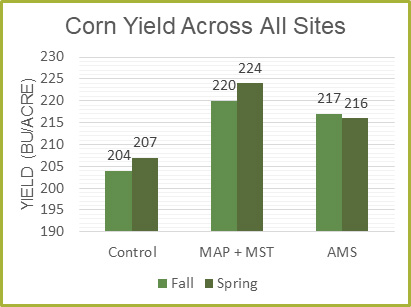Can I Apply Smart Nutrition™ MAP+MST® In The Fall?
Spring fertilizer applications can be difficult to manage considering wet weather patterns and the rush to get fields planted. Fall can present more opportunities for fertilizer applications because of generally drier conditions and labor/time availability. Not all nutrient forms are suited to fall application, so selecting your fertilizer source will help you decide if fall application is right for your farm.
Nutrients like sulfate can be subject to loss with high precipitation events during the fall and winter months. Sulfate leaching loss is a concern for fall applied sulfur. A fertilizer source that contains elemental sulfur may be a better option to protect against leaching losses and allow for more flexibility.
Protection with MST®
Sulfur applied in the elemental form must be oxidized to sulfate before subject to leaching. Smart Nutrition MAP+MST® has a sulfur content of 16 percent, in which roughly 15 percent elemental sulfur as Micronized Sulfur Technology (MST) and 1-2 percent sulfate.
Ideally, Smart Nutrition MAP+MST applications should occur in the fall after soil temperatures drop below 50 degrees. At these cooler temperatures, soil microbial activity decreases and reduce the conversion rate of elemental sulfur to sulfate. Once soils warm in the spring, microbial activity increases and the micronized elemental sulfur in Smart Nutrition MAP+MST converts to plant available sulfate.
Smart Nutrition MAP+MST: Fall versus spring
To determine the impact of sulfur fertilization timing on corn yield, we conducted field experimentation at seven locations in the upper Midwest, across Indiana, Iowa, Minnesota, and Wisconsin. Locations were selected because they had demonstrated sulfur responsiveness in the past, or they had soil conditions favorable to sulfur loss. Comparisons were made between sulfur products at the same sulfur rate. Control plots received no sulfur fertilizer and the difference between fall and spring was when other nutrients like nitrogen and phosphorus were applied. To ensure maximum fertilizer to soil contact, sulfur treatments of Smart Nutrition MAP+MST and ammonium sulfate (AMS or AS) were broadcast applied and incorporated with tillage.
On average, applying sulfur, either as Smart Nutrition MAP+MST or AMS, resulted in roughly a 10 percent increase in corn yield. Results indicated no differences in yield between Smart Nutrition MAP+MST applied in the fall versus the spring at 220 and 224 bushels per acre. This suggests fall applications of Smart Nutrition MAP+MST as a viable option.

The lack of yield differences (fall or spring applied) indicates sulfur oxidation rates of Smart Nutrition MAP+MST were sufficient to match the availability of sulfur from AMS. However, the sulfur in AMS is present as sulfate and can be subject to leaching losses. Applying a sulfur fertilizer that contains only sulfate in the fall can be risky under certain environmental conditions.
Considerations for fall sulfur applications
To ensure maximum sulfur efficiency, here are some guidelines to consider for sulfur applications made this fall:
- Consider the form of sulfur in your fertilizer source. Sulfate is subject to leaching losses and might not be available come spring.
- Soil type can greatly affect the potential for sulfur leaching losses. Coarser textured soils carry higher risk for leaching losses as sulfate can move more easily through the profile compared to finer textured soils.
- Corn is a crop that has shown some consistency to sulfur. Making sure adequate sulfur is available is key to maximizing production. It is always good to double check removal rates of grain and silage harvested.
- Consider past experiences for help determining if and/or when sulfur needs to be applied. If you fall applied sulfur and saw deficiency in the spring, you should consider switching application time or increasing your application rate.
Learn more about Smart Nutrition MAP+MST in our posts about fertilizer characteristics and application. For any questions or comments, send us a message on Twitter @smart_mst.
Trademark of Sulvaris Inc. used under license (or with permission) by Sulvaris Inc.





